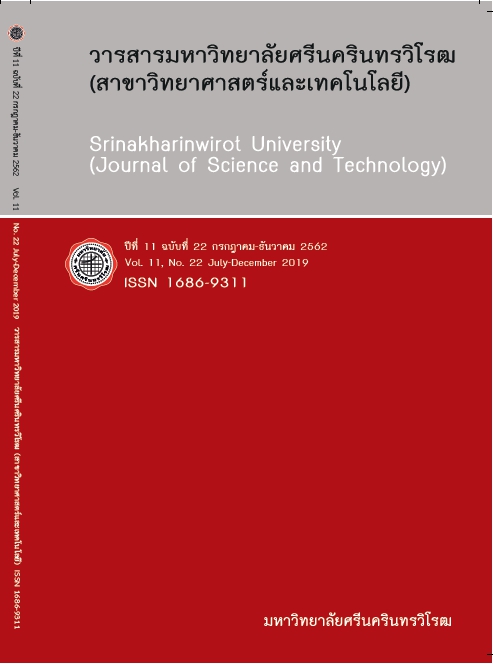การนำมูลฝอยบริเวณสถานที่กำจัดมูลฝอยกลับมาใช้ใหม่ในรูปสารปรับปรุง คุณภาพดิน กรณีศึกษาเทศบาลตำบลปริก จังหวัดสงขลา (THE UTILIZATION OF WASTE AT THE DISPOSAL SITE INTO FERTILIZATION FORMS: A CASE STUDY OF PRIK SUB-DISTRICT MUNICIPALITY, SONGKHLA PROVINCE)
Keywords:
Recycling, Fertilizer, Waste Disposal, Heavy MetalAbstract
The study of waste utilization into fertilizer forms was conducted at the waste disposal site of Prik Sub-district Municipality, Songkhla Province. From the interview with the authorities responsible for the waste management of Prik, including the random sampling collection of the solid waste at the open dumping site, which was categorized by the nature and the span of waste dumping, namely (1) 1-5 years, (2) 6 months to 1 year, and (3) less than 6 months, it was found that the household waste have been managed and sorted systematically as a whole process; starting from the household origin, during collecting procedure, and finally to the waste disposal site. The waste was sorted as organic waste, hazardous waste, general waste, and recycled waste, which the total amount of waste averages four to five tons per day. The dump trucks and the hydraulic garbage trucks were used in the household waste collection and dumping to the open waste disposal site. In the disposal process, the organic wastes were transformed to organic fertilizer, fermented bio-extract, and biomass charcoal; while the hazardous wastes were compiled for further safe disposal process. For general wastes, they were dumped in the open field; whereas the recycled wastes were sorted for further selling. In addition, from the winnowing and the analysis of physical and chemical properties of the wastes, the result shown that the moisture content of all three categories ranges from 19.11-22.78, the pH value shows from 7.3-8.6, and the ash content value indicates from 61.68-74.96%. In terms of the waste categories, it was found that general wastes were found the most around 50.56-63.43%, followed by organic wastes (30.57-40.57%). The essential nutrients found are nitrogen (total N), phosphorus (total P2O5), and potassium (total K2O), with the average unit ranging from 0.34-0.92%, 1.21-1.87%, and 0.63-1.74% respectively. Regarding to the heavy metals, it was found that there were copper, lead and arsenic. The range is from 93.35 ± 2.14, 71.86 ± 1.25, and 3.70 ± 0.28 mg/kg respectively. Furthermore, the oxide analysis of the substance found SiO2 the highest at 42.85%, followed by CaO at 13.88%, Fe2O3 at 8.19% and Al2O3 at 6.97%, respectively. Considering the use of the fertilizer, the solid waste from the open dumping site is in the 2005 national organic fertilizer standard which can be winnowed and reused in the form of recycled fertilizer that is important for the plants’ growth in the future.
Downloads
References
[2] Paibun Chemphong, and Siwaphan Chuin. (2017). Solid Waste Management. Bangkok: Chulalongkorn University Press.
[3] Prik Sub-District Municipality. (2016). Publications of Prik Sub-District Municipality, Songkhla Province. n.p.
[4] Association of Official Analytical Chemists. (1990). Official Method of Analysis. Retrieved form http://www.aoac.org/aoac_prod_imis/AOAC/Publications/Official_Methods_of_Analysis
[5] National Bureau of Standards. (2017). Standard Reference Material Catalog. pp. 1986-1987. Retrieved form http://www.ratchakitcha.soc.go.th/DATA/PDF/2548/00172707.PDF
[6] Department of Agriculture. (2005, November 25). Rules, procedures, and conditions for certification of standardized fertilizer production 2005. Retrieved from http://www.ratchakitcha.soc.go.th/ DATA/PDF/2548/00172707.PDF
[7] Kannika Chukan. (2011). The study of solid waste management systems, Pakkret City Municipality, Nonthaburi province. Thesis Master of Arts. Silpakorn University.
[8] Ingo Holzle. (2017, August). Contaminants in Landfill Soils-Reliability of Prefeasibility Studies. Waste Management. 63, 337-344.
Downloads
Published
How to Cite
Issue
Section
License
Srinakharinwirot University Journal of Sciences and Technology is licensed Under a Creative Commons Attribution-NonCommercial-NoDerivs 4.0 International (CC-BY-NC-ND 4.0) License, Unless Otherwise Stated. Please Read Journal Policies Page for More Information on Open Access, Copyright and Permissions.



